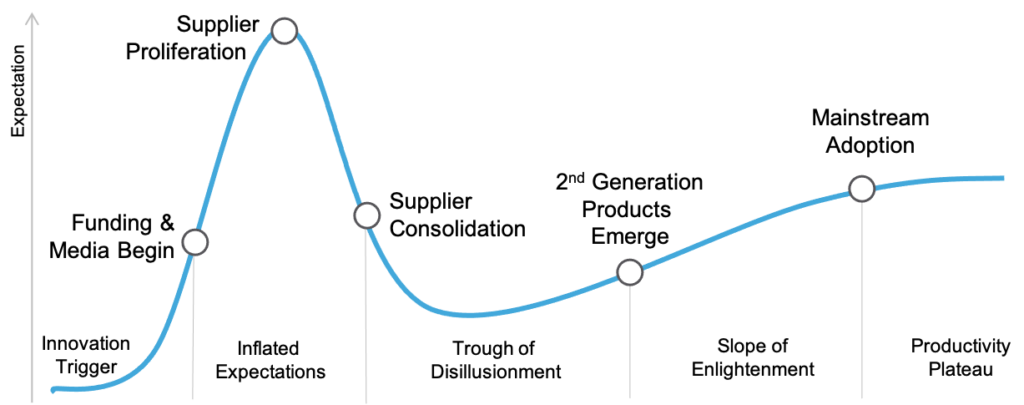What is the Gartner Hype Cycle?
Innovation is key to a company having an advantage (a vital differentiator) over the competition. New technologies often hold or make great promises. Investors and business owners are always on the lookout for the next big thing to enable them to jump on the train early. Emerging tech essentially comes with so much hype in many cases. How do you filter through the noise to identify new technologies that hold real commercial value? The Gartner Hype Cycle seeks to help with that.

What is the Gartner Hype Cycle?
The Hype Cycle is a graphical illustration of a pattern that is commonly observed with new technologies or innovations. It portrays “the maturity and adoption of technologies and applications” as well as how they could provide solutions to real business problems and help make the most of emerging opportunities. This research methodology seeks to provide you with an outlook of how a technology will potentially evolve over its lifecycle. This – it is hoped – will guide how you deploy it while considering your business goals. Businesses can use the cycle to assess how an emerging tech matches their industry as well as risk appetite.
Introduced by analyst Jackie Fenn in 1995, the Hype Cycle has been used by Gartner for years to chart emerging technologies. The research and advisory firm produces more than 100 of this cycle every year in different areas to help clients monitor innovation maturity and future possibility.
The maturity and adoption lifecycle can help you answer a very critical question: is this new technology worth investing in?
Understanding the Hype Cycle
According to this methodology, a new technology goes through five phases. The cycle is reflected in a wavy curve that shows the response or interest in a technology or innovation as it evolves. Gartner makes use of several indicators to come up with a graphical representation of the maturity lifecycle. The x-axis (horizontal) of the Hype Cycle is labeled “Time” and indicates how a technology will progress from one phase to another over time. As for the y-axis, it represents “Expectations” which can go high or drop as time passes.
The following are the phases that have been identified in the maturity of emerging tech:
Technology or Innovation Trigger
This first phase of a potential technology breakthrough is when a public announcement, demonstration, or other event activates interest. Awareness can lead to increased media coverage, which further helps to spread the innovation and causes a surge in expected value. However, there is no usable solution at this point in many cases and commercial viability has yet to be proven.
Peak of Inflated Expectations
With the innovation already widely publicized, some venture capitalists and companies move in at this phase hoping to get a possible first-mover advantage. There are high expectations, which are further boosted by more media coverage. While some companies invest in the technology without a sound strategy, many others take a waiting approach while tracking both success and failure stories. There is a rise in the number of vendors offering competing or complementary products.
Trough of Disillusionment
The high excitement that accompanies the innovation starts to moderate at this stage. Implementations fail to impress, causing a drop in interest. Disillusionment kicks in on poor performance and unmet revenue expectations. The media that helped to build interest also starts to knock the innovation. All this leads to reduced or slowed adoption.
Slope of Enlightenment
Organizations take time to properly assess a technology after the initial seeming disappointment. Some early adopters have overcome the initial difficulties and have started to notice net benefits, which encourage them to move on. Also, other organizations learn from the successful early adopters on the best way to use the innovation. There is an increase in both performance and investment.
Plateau of Productivity
This is the ultimate target. The adoption of the innovation or technology gathers pace at this phase, with benefits having been well demonstrated. The criteria for evaluating provider viability also become better defined.
Dealing with the Traps
Gartner identifies four common traps that are involved in the Hype Cycle, namely:
- Adopting too early
- Giving up too soon
- Adopting too late
- Hanging on too long
The first two traps correspond to the Peak of Inflated Expectations and the Trough of Disillusionment phases. There is a tendency to adopt a technology due to hype and abandon it soon after when it seems to fail to live up to expectations. Technology planners will often advise that you consider adopting an innovation if it matches your organization’s strategy. Otherwise, you wait to learn from the early adopters. The Trough of Disillusionment, when interest wanes, offers a better opportunity to properly evaluate the innovation’s usefulness.
However, care should be taken to not wait too long before adopting an interesting innovation. If your organization identifies one with great potential, a recommendation is to determine and set performance levels or price points that help you to know the best time to jump in. Finally, while the Plateau of Productivity is the target, a technology can drop into obsolescence at some point once there. It can become too costly to continue maintaining technologies at this phase. Therefore, letting go could make better sense


